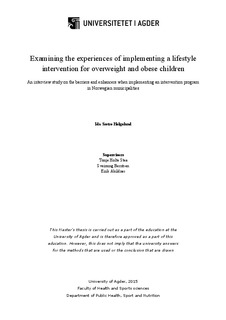| dc.description.abstract | Background: Childhood obesity is one of the 21st century’s most serious public health
challenges. In Norway, health nurses are obligated to record children’s body mass and
children who are classified as overweight or obese should be offered a follow up through
lifestyle programs. There has been a lack of such lifestyle programs, however, some
municipalities have implemented intervention programs to support overweight and obese
children and their families’ lifestyle changes.
Aim: To examine how a lifestyle intervention focusing on promoting healthy lifestyle habits
in overweight and obese children and their families in three different Norwegian
municipalities was implemented and conducted. The intervention focused on physical
activity, diet and individual guidance. Important enhancers and barriers related to the
implementation process were identified.
Methods: In depth interviews were conducted with representatives (n=5) involved in the
implementation process in three different municipalities. All interviews were recorded
digitally, transcribed verbatim and analysed using systematic text condensation.
Results: An initiator to establish agreements in the municipality council was identified as an
important enhancer in the implementation. Barriers in the implementation were related to the
cooperation between the program facilitators, municipal council and the health nurses.
Resistance from the participating children’s parents and a lack of program founding were also
identified as barriers. There was a lack of structured evaluations of the intervention programs.
The intervention programs components were identified as important focus areas, including
connection to local community, physical activity sessions, diet courses, individual counselling
and involvement of the entire family.
Conclusion: Involvement of a determined individual with strong sense of commitment seems
essential for implementing such intervention programs. For future work, better strategies to
involve health nurses and how they should approach the families are needed. Thorough
program evaluation should be conducted to examine the intervention program’s effect, why
they were successful or not, and to ensure future funding. | nb_NO |
